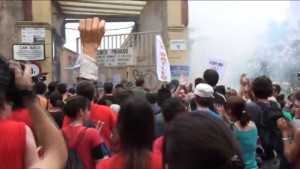
In spite of all the scholarly studies on the importance of preserving Barcelona’s ancient factories (Tatjer 2008), the usual practice in postindustrial urbanism has been their systematic demolition, sometimes preserving isolated chimneys: more than industrial memory, they seem to celebrate the annihilation of the worker’s movement. The conflicts around the industrial complex of Can Batlló, a 13 ha. late-XIX-century factory in La Bordeta district (Sants, Barcelona), almost completely abandoned, opposed (as usual) on one side the greed of the landowners, with the complicity of the City Council, and on the other the needs and demands of the district’s residents.
But this time – differently as it happened for Can Ricart (Poblenou) or Can Fabra (Sant Andreu) – the residents’ associations won a battle: on june 11th, 2011 a massive occupation of Can Batlló [see videos: video1 – video2 – video3] increased the pression on the City Council and Gaudir company, and broke the deadlock. The action had an unexpected result: one of the pavillons of the factory was offered to the neighborhood associations, so now residents can organize activities on a new space, and enter – through their direct action – into the debate about the future of industrial heritage.
- Marc DALMAU (2014) “Can Batlló, de la degradación planificada a la construcción comunitaria“, en Quaderns-e de l’ICA n. 19 (1), 143-159. “Is is so hard to imagine that workgroups in which technicians and citizens together can design, think and execute the urban development plans? Who better than its inhabitants can design and even self-construct an urban environment according to their own needs?”
- Vídeo Can Batlló, una realitat, by Natxo MEDINA (Assemblea del barri de Sants, 2011) [ver en Vimeo]. “This is an occasion to show that things only change if the people who need it get into action. If we keep waiting that our needs are recorded in enquiries, reflected in electoral programs, taken to the City Council, and solved from there, when they found the money and make the projects, we will never have what we need” (F. Aguiló).

- Let’s imagine another Can Batlló (PDF): reflections on the future of the industrial complex (summary of the meeting on june 13th, 2011).
- Webpage of Plataforma Vecinal Can Batlló és pel barri: the victory of june 11th is the result of 35 years of struggles, of many organized moments of collective reflection and of one year of intense campaign “Can Batlló belongs to the neighborhood“.
- Sants’ district has a long story of residents’ platforms and meeting places where different social and political sectors of the district could converge: see La Hamsa, Can Vies, Centre Social de Sants, Assemblea del Barri, Plataforma Soterrem les Vies, La ciutat invisible
- Horacio CAPEL (1996) La rehabilitación y el uso del patrimonio histórico industrial, en Documents d’Anàlisi Geogràfica n.29, pp.19-50. [ENLACE]. “It’s strange this obsession with factory chimneys: it is one of the elements most often preserved, maybe for the little space they take, maybe for it’s association with industrial activity, maybe because they have a phallic aspect”.
- Arnau GONZÁLEZ I VILALTA, “L’Ateneu Llibertari de Sants (Barcelona), 1976-1982”. Actes del Congrès La transició de la dictadura franquista a la democràcia, Barcelona 20-21-22 d’octubre de 2005. Pp. 330-339 [LINK]
- More links on industrial heritage in Barcelona and in Spain: Web patrimonio industrial Barcelona; Sudor, vapor y lágrimas; Patrimonio industrial arquitectónico.
